
After months of anticipation for the European Vulture Conference, it is finally here! Around 200 participants joined us in the Algarve to celebrate vultures for four days.
The first day of the conference is now over, and it has been filled with many fascinating presentations from conservationists in Europe and beyond. Here are some of the highlights.
Welcome – Daniel Hegglin and José Tavares
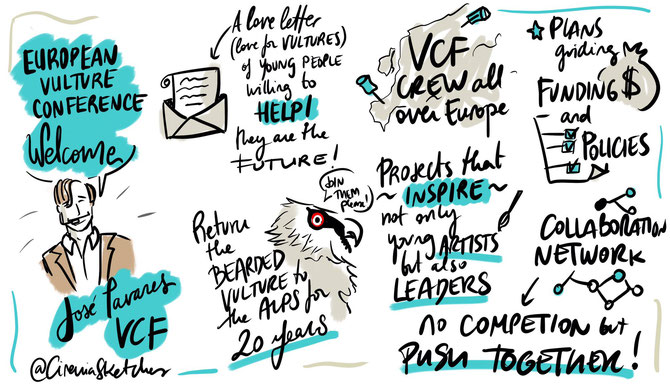
Our president and director have welcomed the participants to the conference with some conservation optimism, sharing recent and old success stories, some dating back to the beginning of the VCF.
François Sarrazin
Restoration and conservation of scavenger populations
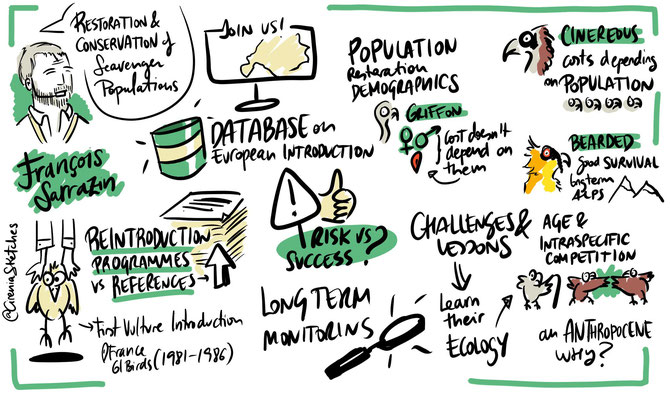
Francois Sarrazin opened the scientific programme with a presentation about the restoration and conservation of scavenger populations. He announced that a new database for metadata about reintroduction projects in Europe is being launched.
Franziska Lörcher
Bearded Vulture reintroduction in Europe

Our science and conservation coordinator, Franziska Lörcher, took us through the history of the Bearded Vulture reintroduction in Europe, from the early days of captive breeding to the first releases in the Alps in the 1980s. The reintroduction of the species happens with the hacking method, which is the most natural way to release chicks into the wild. For this to be a longterm success, public engagement and participation are critical. And of course, collaboration and cooperation across international borders among many organisations is another key to success.
Orr Spiegel
Vulture foraging movements as a mixed strategy and its dependency on social information
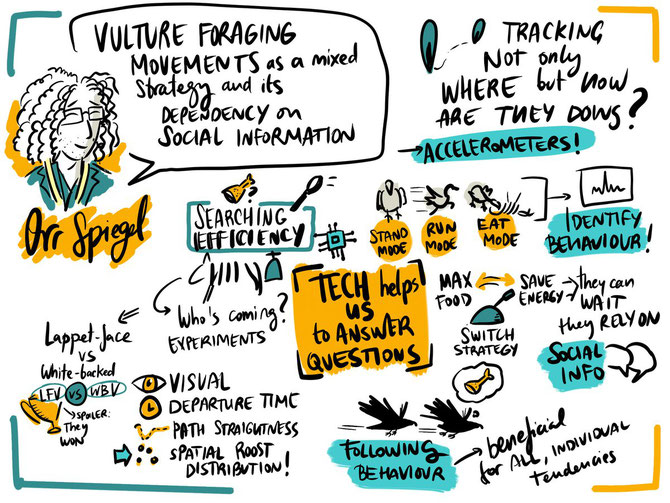
Orr Spiegel, another keynote speaker, presented research into vulture foraging efficiency and the importance of social information. Lappet-faced vultures are good at detecting new carcasses, partly due to the widespread distribution of roosts, White-backed vultures benefit from this through social facilitation. Accelerometry data has been used to investigate how hunger influences vulture movement strategies. Furthermore, he shared that vulture foraging efficiency depends on vultures learning from other vultures where carcasses are or might be.
The take-home message from this talk is that ‘united we stand, divided we fall.’
Olivier Duriez
Flight and foraging decision making in Griffon Vultures
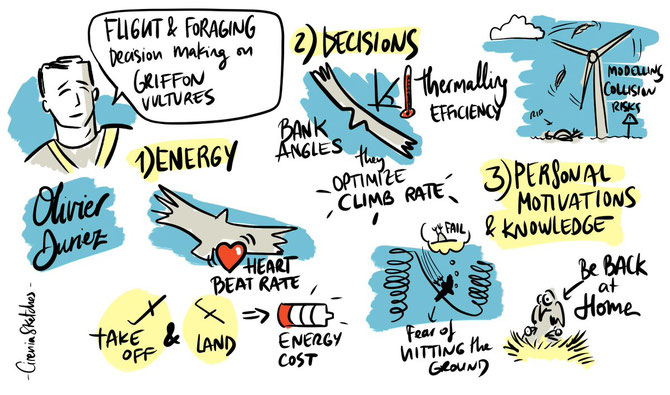
Dr Olivier Duriez presented his work on Griffon Vulture flight energetics. He shared some fascinating insights into trade-offs for soaring birds, which has implications for understanding and mitigating risk of collision with wind turbines.
Pascual López-López
Spatial and temporal variability and flexibility in migration of a globally endangered avian scavenger across three continents
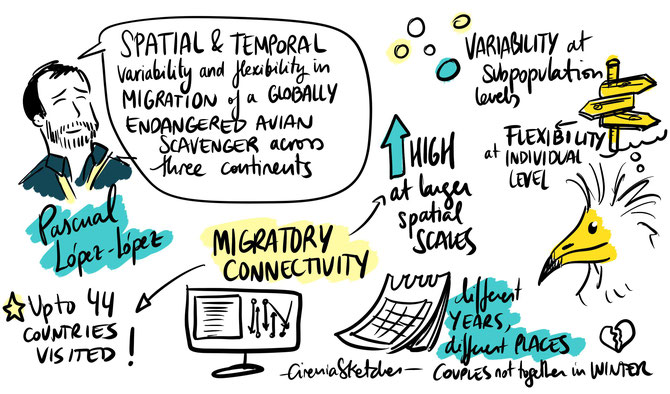
Dr Pascual López-López discussed the importance of collaborative effort to study migration performance and flexibility of Egyptian Vultures. A recent milestone study that involved more of 40 people and 11 projects, analysed the migration of 94 Egyptian Vultures across three continents. This international collaboration for Egyptian Vulture conservation is a first step to help inform conservation action.
Andrea Santangeli
Priority areas for conservation of Old World vultures
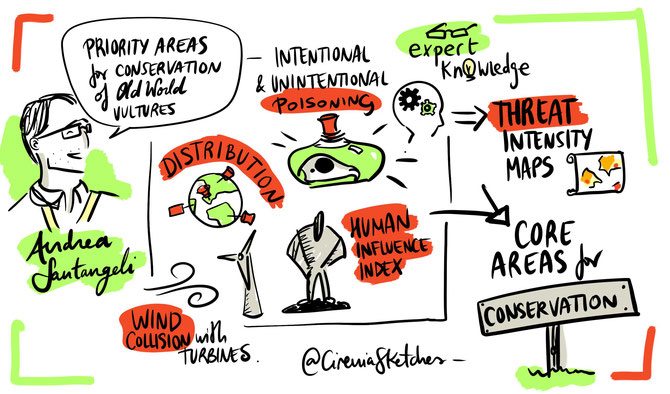
Dr Andrea Santangeli discussed his work assessing how to set spatial priorities for conservation of Old World vultures. One of the ways is by identifying important areas for vultures where threats are high, and where conservation action is urgently needed. There are only 19% of priority areas covered by the protected area network – we also need to work in unprotected land.
Daniel Hegglin
GPS tracking in vulture conservation: science, surveillance and communication
Our president Daniel Hegglin discussed how GPS tracking is used in vulture conservation. For the reintroduction project in the Alpine project, the elastic leg harness is a method of choice since this is comparatively easy to mount and best suited for Bearded Vultures based on years of experience.
Marina Garcia-Alfonso
Conservation through the spatial ecology of the Canarian Egyptian Vulture
Marina Garcia-Alfonso talked about conservation through the spatial ecology of the Canarian Egyptian Vulture. She presented a research scenario for Egyptian Vultures and the effects of feeding stations on the species. The majority (90%) are tagged with colour rings and 50 individuals are tagged with GPS transmitters. She further shared some interesting insights about their feeding behaviour. More vultures prefer farms with a larger number of livestock. Territorial birds prefer to visit feeding stations close to their nests.
Fiammetta Berlinguer
How is LIFE going Under Griffon Wings? An update on the status of the Griffon Vulture (Gyps fulvus) population in Sardinia
Fiammetta Berlinguer gave us an update on the Griffon Vulture population in Sardinia, sharing hope for the future. Since the start of the LIFE Under Griffon Wings project, the population of the species is significantly increasing. In addition to the positive news about Griffon Vultures, she shared some positive news – this year they observed the first breeding record of Egyptian Vultures in Sardinia. The fledging is called Primo, which means first in Italian.
Nikos Kassinis
Griffon Vultures of Cyprus – legacy of conservation past and looking to the future
Nikos Kassinis took us through the situation of Griffon Vultures in Cyprus. Unfortunately, colonies have decreased systematically over the years, and today there is only one active colony. There are only a few pairs on the island, so conservation actions are trying to change that. In the past, they attempted to do so with the LIFE Project ‘Gypas’, which focused on reinforcement and supplementary feeding. Furthermore, another project will shortly launch to conserve the species on the island. The LIFE with vultures project, in which we are also partners, will further tackle poisoning and collisions.
Carlos Pacheco
Vultures in Portugal: An historical perspective
Carlos Pacheco discussed the situation of vultures in Portugal. Overall the situation is positive, and all populations are doing relatively better. It should improve if food shortage is tracked, poisoning decreased, conflict with humans is reduced, and habitat degradation is controlled.
Egyptian Vultures decreased by the turn of the century but then remained more or less stable ever since. Griffon Vultures also decreased by the beginning of the 21st century, but the population recovered quickly since. Cinereous Vultures suffered a lot and went extinct as a breeding species in the 1970s. It came back as a breeder in 2010. Today, there are 25-30 pairs in 3 colonies. Bearded Vultures are a scarce breeder. They became extinct in 1880. But now there are a few records from reintroduced birds. The Rüppell’s Vulture has attempted breeding at least twice since 2005 and is now seen regularly and increasing.
Louis Phipps
Movements and space use of Egyptian Vultures tracked from the Douro Valley
Our Research Officer discussed the movements and space use of Egyptian Vultures tracked in the Douro Valley from our LIFE Rupis project. Surface water, livestock farms, and livestock manure dumps were key for species foraging and habitat selection. There is an area of overlap of four individuals on the Mali-Senegal border. This is a newly defined wintering area for this population thanks to GPS tracking. There is a need for more cooperation on the field from W African countries.
You can keep up to date with the latest updates of the conference by following the hashtag #Vultures2019. We are live-tweeting some of the fascinating presentations, so make sure you follow us on Twitter!
The European Vulture Conference
1-4 October
Algarve, Portugal

For the first four days in October, we will be bringing together scientists, conservationists and the public in Algarve, Portugal for an international congress on vultures in our first European Vulture Conference. World-leading speakers will be shaping the conversation on the latest research and conservation studies about vultures in Europe and beyond. On the last day of the conference, we will venture out and explore the local nature. The Algarve is known for its wetlands, woodlands and other habitats that are rich in biodiversity, so get ready for a fantastic day out in nature!



